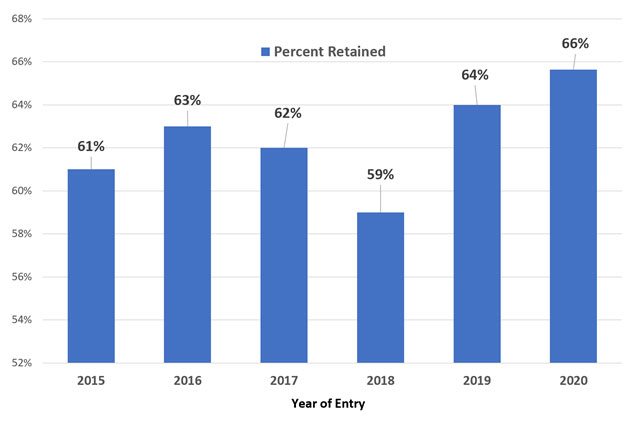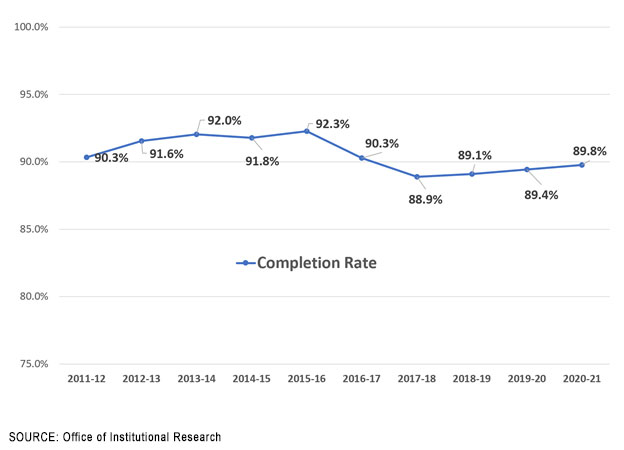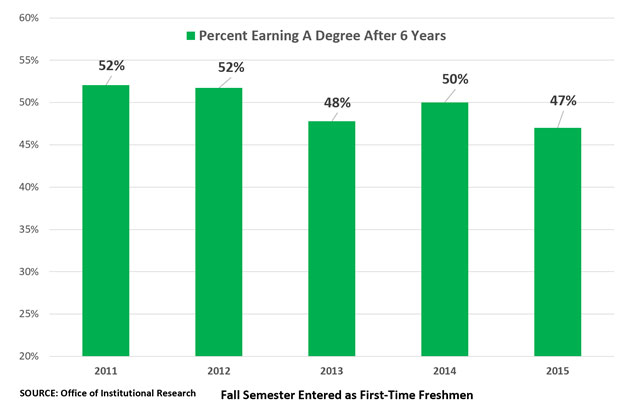Consistent with its Mission and Core Values, Virginia Wesleyan University (VWU or the University) seeks to “engage students of diverse ages, religions, ethnic origins, and backgrounds in a rigorous liberal arts education that will prepare them to meet the challenges of life and career...” The current strategic plan, Forging Our Future: Building On Strength 2020-2030, describes a vision under which the College “will be a beacon for the liberal arts in the 21st century.” The plan identifies “academic excellence” as the first of five Core Values [provide link] Thus, the College is committed to continuous improvement of its academic program and student success, as it seeks to become a nationally eminent liberal arts college.
The institution identifies, evaluates, and publishes its goals and outcomes with respect to institutional student achievement by utilizing a coherent and relevant list of multiple measures of success, including: freshman enrollment profile data, retention, course completion, graduation rates, and participation in experiential learning activities. Both main campus and online students are included in the student achievement measures. Success in these achievements relates directly to the Mission of Virginia Wesleyan University, which is
...dedicated to scholarship and service grounded in the liberal arts and sciences, . . . [while seeking to inspire] students to build meaningful lives through engagement in Coastal Virginia's dynamic metropolitan region, the nation, and the world.
The following measures have been chosen to monitor student achievement at Virginia Wesleyan University. All measures include campus-based and online students.
Definition: The percentage of entering first-time freshmen who are re-enrolled one year later.
Rationale for Selection: Retention rate is a commonly used measure to determine the extent to which students are making satisfactory progress in meeting their academic goals and progressing to degree completion. Monitoring this measure, along with other related measures, alerts the faculty and administration regarding actions needed to improve support for students to be successful.
Calculation: First-time freshmen entering the University in one fall semester are tracked to determine their subsequent enrollment in the fall semester one year later.
Threshold: The threshold retention rate for first-time freshmen is 62%. This threshold was established based on recent history in retention rates and an analysis of admission, academic support, and student support efforts.
Performance: For freshmen classes entering the College during the period 2015 to 2020, the first year retention rate varied between 59 and 66 percent— a rate most recently near the 50th percentile for Southeastern CIC institutions (for the period 2014 through 2018, the 50th percentile rate (median) was 68 percent) For VWU’s 2021 first-year class, the retention rate was 66 percent, an increase of 2 percent over the prior first-time freshman class.
Figure 8.1-1 Fall to Fall Retention Rates By Entering Class Year

A recently implemented initiative to improve retention is the WesBridge Program. Piloted in the summer of 2021, the program serves as a bridge between high school and college. Students in the program are provided the opportunity to jump-start their college education and further develop their academic skills, so that their transition into college is as smooth as possible. The program takes place in August prior to the start of the semester and allows students to take one class and earn two credits. Students who successfully complete the program will start the fall with two semester credit hours already completed toward graduation requirements. Students are selected for the program based on academic history, first-generation status, or social/emotional health and wellbeing. Going forward, the program strives to enroll 50 students each summer. Students who successfully complete the program start the fall semester with the rest of the first-year student cohort. Students who don’t successfully complete the program are provided with criteria that they must adhere to throughout their first full semester or are withdrawn from the institution. Students will be tracked throughout their time at VWU to determine effectiveness of the program and how well and how many persist.
Definition: A course is considered to be completed if the student has not (1) dropped/withdrawn from the course, (2) taken an incomplete grade, or (3) failed the course. While some students must leave a course for unanticipated personal reasons, there are instances where the University could intervene to support improved completion of courses.
Rationale for Selection: Information on the rate at which students complete courses can help the University identify places in the curriculum delivery where students encounter unusual difficulties. Students who fail or withdraw from courses are less likely to persist because low grades or course withdrawals will extend the time to degree. Thus, course completion data can offer insight regarding problems of retention and graduation and guide development of interventions. Internally, completion rates are examined by individual courses to determine if actions with regard to particular courses are necessary.
Calculation: Course registrations and grades are analyzed after the end of the semester . The percentage of registered students who have not dropped/withdrawn, taken an incomplete, or received a failing grade in the course are defined to have completed the course.
Threshold: The threshold course completion of eighty-eight percent (88%) is considered an acceptable target for course completion because some interruptions are outside students’ control, while others might improve with interventions.
Performance: Figure 8.1-2 displays course completion rates academic year (fall and spring) between 2011-12 and 2020-21. Rates during this time fluctuated a small amount between 88.9% and 92.3%. After a decline a few years ago, completion rates have begun to increase in most recent semesters. The University has made a holistic effort to improve student retention through cooperation of offices across campus. A recently implemented initiative to improve retention is the WesBridge Program preparing high school students for success is discussed in the Retention section above. Students in the program are provided the opportunity to jump-start their college education and further develop their academic skills, so that their transition into college is as smooth as possible.. In Academics, the Academic Alert system became better systematized and effective when, in 2019, it became a function of the responsibility of the Associate Vice President for Academic Affairs and the staff of the Learning Center. Faculty submit Academic Alerts when they observe patterns in coursework that cause concern. The Academic Alerts provide the opportunity to intervene and assist, and when appropriate provide referrals for counseling, tutoring, and advising services to enable such students to succeed in their coursework. The purpose of the system is to help every student successfully complete courses, and the reporting and recordkeeping are strictly non-punitive.
The Associate Vice President for Academic Affairs and the Coordinator for University Advising work in concert with the University Care Team, which brings together information from Academics, Campus Life, Student Health Services, Residence Life, Athletics, and Financial Aid to help support student success.
Figure 8.1-2 Course Completion Rates by Academic Year

Definition: The percentage of full-time first-time students (entering freshmen) who earn a bachelor’s degree in six years after entry.
Rationale for Selection: Graduation rate is a commonly used measure to determine the extent to which students are making satisfactory progress in meeting their academic goals and progressing to degree completion. Monitoring this measure, along with other related measures, alerts the faculty and administration regarding actions needed to improve support for students to be successful. Examination of data by gender, race, and socioeconomic status, provide detailed information to assist the faculty in targeting needed student support efforts.
Calculation: First-time freshmen entering the University in one fall semester are tracked to the end of what would be their sixth year of enrollment to determine whether or not they have earned a bachelor’s degree.
Threshold: The target threshold for graduation rate is 48 percent. This threshold was established based on history of retention rates, recent graduation rates, and an analysis of admission, academic support, and student support efforts.
Performance: Over the past five years, the University’s graduation rates have ranged from 47% to 52%. The 2013 rate of 48% is above the 50th percentile for Southeastern CIC institutions (for the period 2009 through 2013, the 50th percentile rate (median) was 47 percent). See Figure 8.1-3 below.
Figure 8.1-3 Six-Year Graduation Rates By Entering Class Year

As previously discussed, several interventions have been applied to improve retention, student academic success, and graduation. A recently implemented initiative to improve retention is the WesBridge Program preparing high school students for success is discussed in the Retention section above. Students in the program are provided the opportunity to jump-start their college education and further develop their academic skills, so that their transition into college is as smooth as possible.. In Academics, the Academic Alert system became better systematized and effective when, in 2019, it became a function of the responsibility of the Associate Vice President for Academic Affairs and the staff of the Learning Center. Faculty submit Academic Alerts when they observe patterns in coursework that cause concern. The Academic Alerts provide the opportunity to intervene and assist, and when appropriate provide referrals for counseling, tutoring, and advising services to enable such students to succeed in their coursework.
Definition: Contemporary pedagogical research has identified the “high impact practices” that most effectively impact student engagement and thereby contribute to persistence and student success. Many of the “high impact practices” are various types of courses and course activities that result in experiential learning, which means learning by doing rather than by absorption and comprehension of information. Three prominent high-impact practices have become an important focus in the VWU curriculum by virtue of their centrality to the University’s comprehensive curricular reform of 2011, and the focus of the 2015 Quality Enhancement Plan (QEP). These include Internship courses, undertaking Study Away experiences, and performing Undergraduate Research.
Rationale for Selection: Following from the QEP, enhancing student participation in experiential learning has persisted as a meaningful measure of student achievement for VWU. Strengthening participation in the three experiences directly serves the first of the six goals of VWU’s 2020 Strategic Plan, to provide a transformative educational experience.
VWU highly values experiential learning experiences and expects that they enhance student graduation rates. These high impact practices help students to transfer classroom knowledge into professional settings. Students who participate in these types of experiences are more engaged, thus this data allows us to consider which students are accessing these resources and how these connect to other measures.
Calculation: Graduating seniors’ successful completion of a course specifically associated with one or more of the internships and study away were tracked. Participation in research with a faculty member were tallied from faculty records. Percentages of total graduating class were calculated.
Thresholds: Until stability of offerings has been reestablished following the COVID epidemic, thresholds will remain at 2019-20 levels. The threshold for internships in 38% participation. The threshold for research is 24% participation. The threshold for study away is 4 percent participation. The threshold for completion of at least one experience is 58%.
Performance: With the 2015 pilot implementation of the Quality Enhancement Plan and full implementation in 2016, increases on the experiential learning measures would be expected. Table 8.1-1 illustrates that participation rates have fluctuated considerably across measures, with 2019-20 reaching a particular low point on all. The 2019-20 performance included the semester that COVID-19 became widespread.
Table 8.1-1 Graduates Who Completed a Mastery Level Experiential Course, 2010-11 to 2019-20
| 2010-11 | 2011-12 | 2012-13 | 2013-14 | 2014-15 | 2015-16 | 2016-17 | 2017-18 | 2018-19 | 2019-20 | |
|---|---|---|---|---|---|---|---|---|---|---|
| Internship | 39% | 42% | 32% | 42% | 41% | 41% | 39% | 39% | 44% | 38% |
| Research | 30% | 39% | 40% | 46% | 45% | 45% | 49% | 43% | 40% | 24% |
| Study Away | 2% | 2% | 2% | 4% | 5% | 7% | 4% | 7% | 6% | 4% |
| Completion of at least one experience | 62% | 65% | 59% | 70% | 70% | 73% | 72% | 66% | 71% | 58% |
The University is committed to continuing the success of the QEP. The Lighthouse, as the center of experiential learning, is a permanent campus fixture. All experiential learning programs will continue to collect data and assess progress to inform future efforts. Future efforts will also be supported by the University's new General Education program, implemented in 2019. The new General Education program is anchored in developmentally sequenced seminars, structures analogous to curricular successes of the QEP. Both the University’s core curriculum and experiential learning now have scaffolded developmental structures to more effectively support students.

